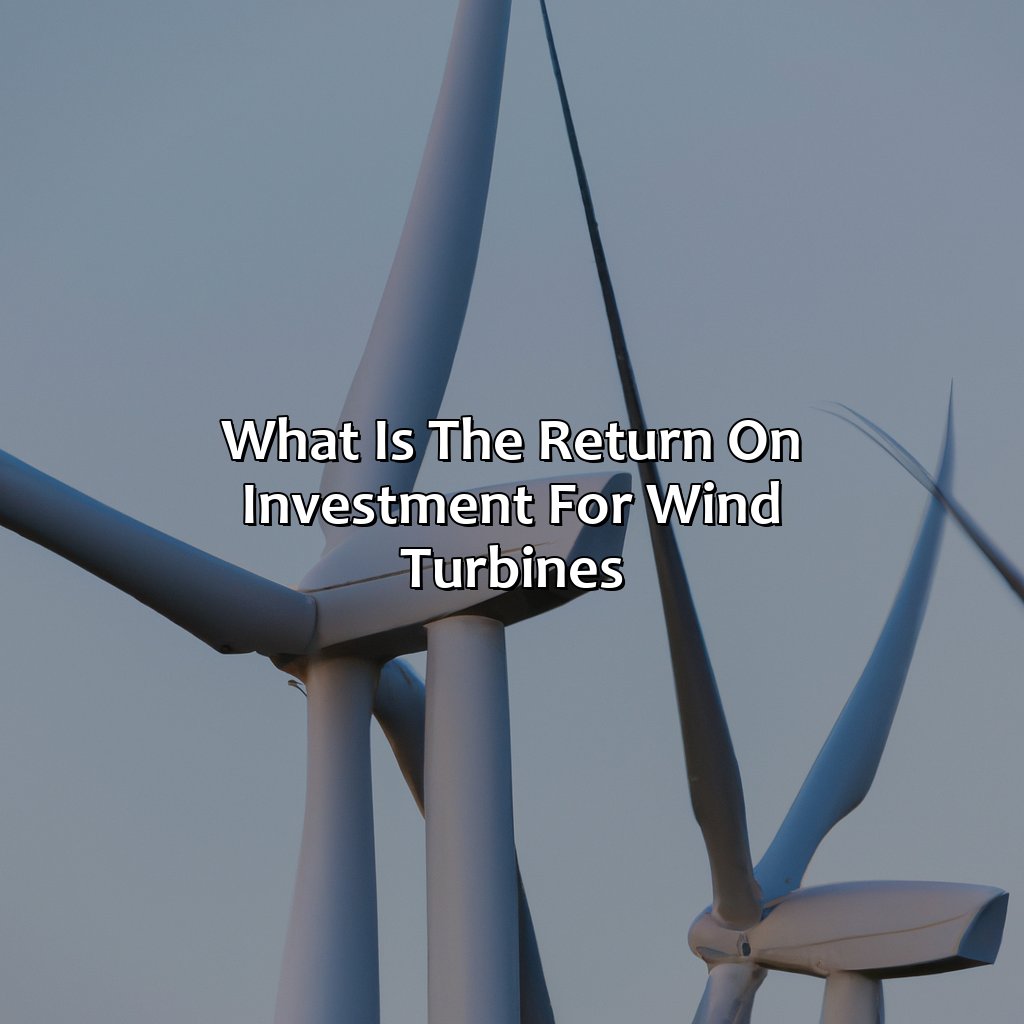What Is The Return On Investment For Wind Turbines?
Key Takeaway:
- Investing in wind turbines can provide a high return on investment: Wind turbines have a long lifespan and can generate electricity for 20 to 30 years, making them a reliable and profitable investment. In addition, government incentives and tax credits can further increase the return on investment.
- The return on investment for wind turbines is affected by several factors, including location and wind speed: Wind turbines are most effective in areas with consistent wind speeds of 6 meters per second or more. Additionally, locating wind turbines in areas with high electricity costs can increase the return on investment.
- To calculate the return on investment for wind turbines, consider factors such as payback period, internal rate of return, and net present value: These calculations take into account factors such as equipment costs, maintenance costs, and electricity production to determine the profitability of the investment.
Are you considering investing in wind turbines but unsure of their return? This blog will help you understand the economic benefits offered by wind energy and the investments that can be made. With the potential for high returns, explore how investing in wind can be beneficial for you.
Overview of Wind Turbines as an Investment
The Financial Benefits of Wind Turbines
Wind turbines have become a popular investment option for individuals and businesses alike. Wind turbines offer a renewable energy source while simultaneously generating revenue. Returns vary depending on the location, size and capacity of the wind turbine. Investing in wind turbines can provide a return on investment that exceeds traditional investments, while still providing a stable and safe investment opportunity.
A thorough analysis of the investment potential of wind turbines is important before investing capital. This analysis should consider factors such as maintenance costs, regulatory requirements, and potential government incentives. Alternative energy markets are increasingly competitive, and analyzing these factors will help identify the most profitable sites for wind turbines.
Wind turbines offer long-term financial benefits in the form of multiple revenue streams, including electricity sales and renewable energy credits. Additionally, wind turbine investments are typically long-term investments, spanning over 20-30 years and providing a stable source of revenue during that time period.
Historically, wind turbines have been an increasingly lucrative investment option as government incentives and renewable energy regulations have been put in place. Major corporations, like Google, have also increased investment in renewable energy sources, further highlighting wind turbines as a profitable investment.
Investing in wind turbines offers a unique opportunity to generate wealth while positively contributing to the environment. Careful consideration of the site and regulatory environment is necessary, but with proper planning, wind turbines can provide a high return on investment and financial stability.
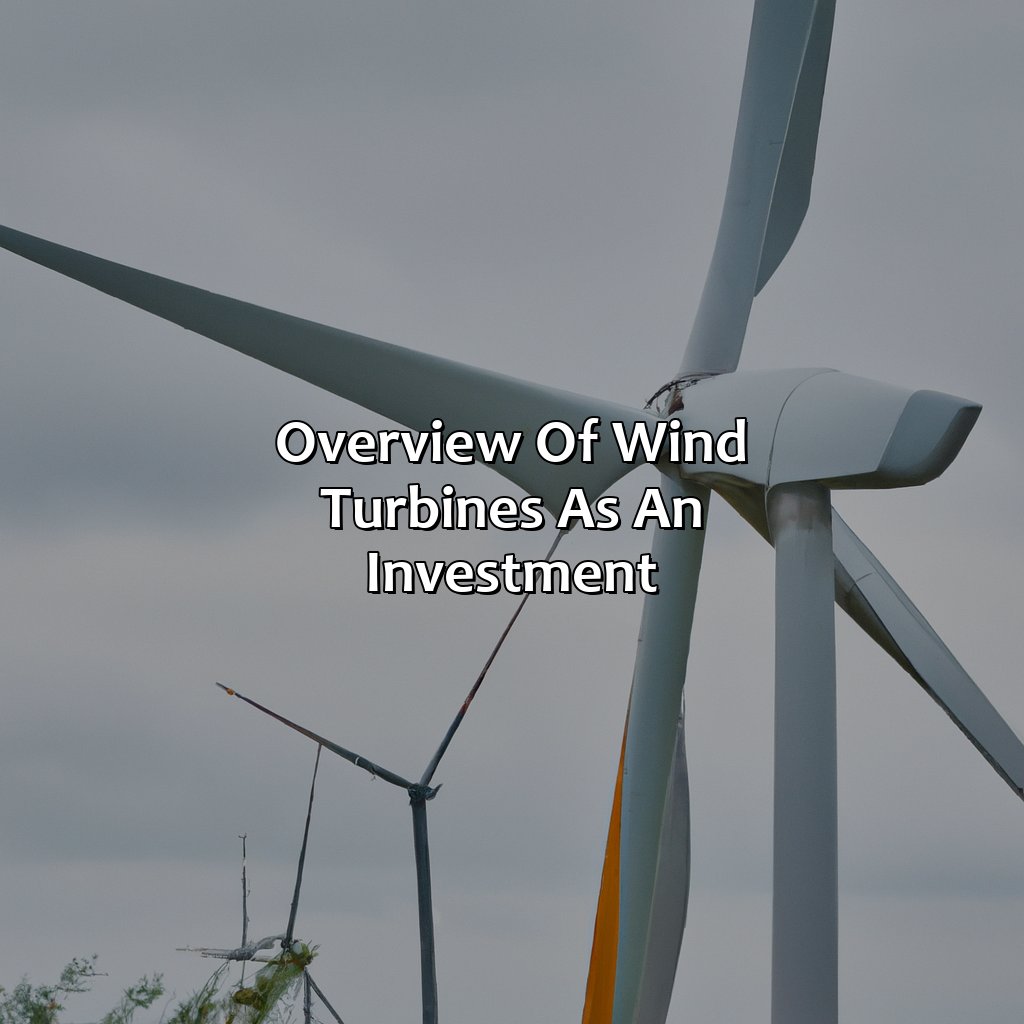
Image credits: retiregenz.com by James Jones
Factors Affecting Return on Investment for Wind Turbines
To understand the ROI of wind turbines better, you should contemplate the spot, wind speed, equipment expenses, and upkeep costs. These parts are essential in deciding how cost-effective the turbines are. If you evaluate these factors with attention, you can take wise decisions and maximize your return on investment.
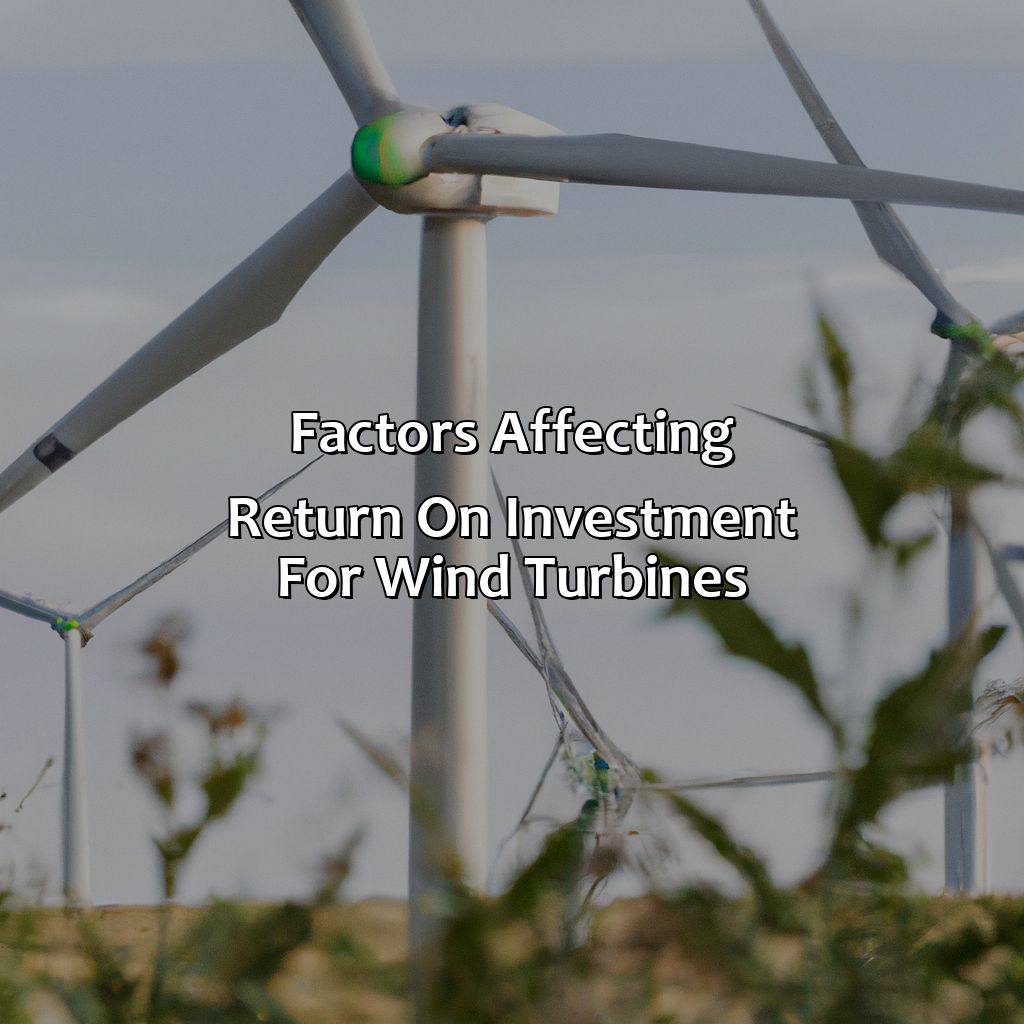
Image credits: retiregenz.com by James Washington
Location
The geographical location of wind turbines plays a crucial role in determining the return on investment (ROI). Wind turbines should be installed where there is a consistently high average wind speed, minimal turbulence, and low obstruction.
Additionally, wind turbines should be located near existing grid infrastructure to reduce connection costs and increase energy production. The accessibility of the site is also essential for maintenance activities to ensure maximum uptime of the equipment.
It is essential to note that different locations have varying incentives and policies that affect the ROI of wind turbines. Therefore, investors must research and understand the local regulations before investing in wind power projects.
Investors should keep an eye on emerging technologies like machine learning and big data analytics that can optimize wind resource assessment and performance monitoring for better ROI. Failing to invest in such technologies may result in missing out on opportunities to increase profits while simultaneously contributing towards clean energy production.
I guess it’s true what they say, when it comes to wind turbines, it’s all about that base… wind speed.
Wind Speed
The velocity of air movement is a significant factor in wind turbine performance. Wind speed variation can change the amount of energy production drastically. Turbines need specific minimal wind speeds to start operating and optimal rates to produce maximum output.
Wind turbines come in different sizes, and each turbine has a different low-speed threshold for starting. The low-speed limit must be offset by higher-weight reducing torque values. Experts establish a wind turbine installation on areas with topographical features that enhance the speed and flow of wind. It ensures the turbines produce optimum power at reduced maintenance costs.
When designing or installing wind turbines, engineers use specialized equipment to assess average wind speed data for long periods (typically between 6-12 months), which helps determine whether the area is right for the purpose intended. Different regions require unique specifications because they have other averages, measuring parameters, and turbulence intensities.
Proper measurements help determine capacity factors that measure how much electricity the plant produces compared to its total potential output capacity based on assumptions planted on average wind speeds measured.
To maximize returns on investment in wind turbines, developers must factor in aspects such as location, turbine size, type (horizontal or vertical axis), available subsidies/financial incentives and project lifespan/costs. Neglecting these considerations could lead to insufficient income from energy sales relative to expenses on maintenance and debt repayment.
Don’t miss out on investing in renewable energy – consider partnering with reputable companies with a track record of successfully exploiting renewable resources.
Wind turbines may save the planet, but they also cost a windfall – the equipment costs will blow you away.
Equipment Costs
The initial investment to set up a wind turbine system is paramount to the overall success of the venture. The capital cost for installing and maintaining equipment directly affects the return on investment (ROI). Therefore, maximizing equipment efficiency and minimizing maintenance costs is essential to a successful wind turbine project.
The main cost considerations for setting up a wind turbine system include:
- Investment in high-quality turbines
- Purchase of additional components, such as control modules
- Transportation fees
- Installation charges
- Maintenance and repair expenses over time
It’s important to note that cutting down on equipment costs alone may not be an effective way to boost ROI. Using low-quality equipment can result in unreliable energy production and higher maintenance costs over time. Instead, investing in top-of-the-line turbines could provide a better ROI in the long run.
Wind turbine technology has been perfected over many decades, improving reliability and boosting energy generation capacity. For example, early wind turbines had inefficient blade designs that resulted in lower electricity generation rates; however, advancements have led to greater efficiency that translates into better ROI for investors.
The history behind the costs of wind turbines has constantly changed due to technological advancements. Over time, the price has decreased as products have become more efficient resulting in better power output from the same amount of wind. It’s important for potential investors to keep up-to-date with these changes so they can make wise decisions regarding their investments.
Maintaining a wind turbine is like having a needy pet that produces electricity, but instead of scratching your couch, it scratches your wallet.
Maintenance Costs
Wind Turbine Upkeep Expenses
Maintaining wind turbines is a crucial factor in maximizing return on investment. It includes routine activities such as oil changes, bolt tightening, and blade inspections. These are essential to keep turbines operating at optimum output levels and prolong turbine lifespan.
Additionally, major repairs such as gearbox replacements or blade refurbishments can be expensive but necessary to avoid downtime. Other factors affecting maintenance costs include location, age of turbines, and weather conditions.
It is important to budget for upkeep expenses during the planning phase to ensure long-term profitability. Neglecting regular maintenance activities can result in higher repair costs and lost revenue due to downtime.
A developer in Texas faced significant financial loss due to hurricane damage to their wind farm. A proactive approach towards preventive maintenance could have reduced the damage and avoided lengthy downtime, resulting in financial gain.
Get ready to crunch some numbers, because calculating ROI for wind turbines is about to blow your mind.
Calculating Return on Investment for Wind Turbines
Calculate the return on investment for wind turbines. Payback Period, Internal Rate of Return, and Net Present Value are the solutions. These subsections aid in figuring out how long it takes to get the first investment back. Plus, the rate of growth of the investment and the possible profitability of the investment in current currency.
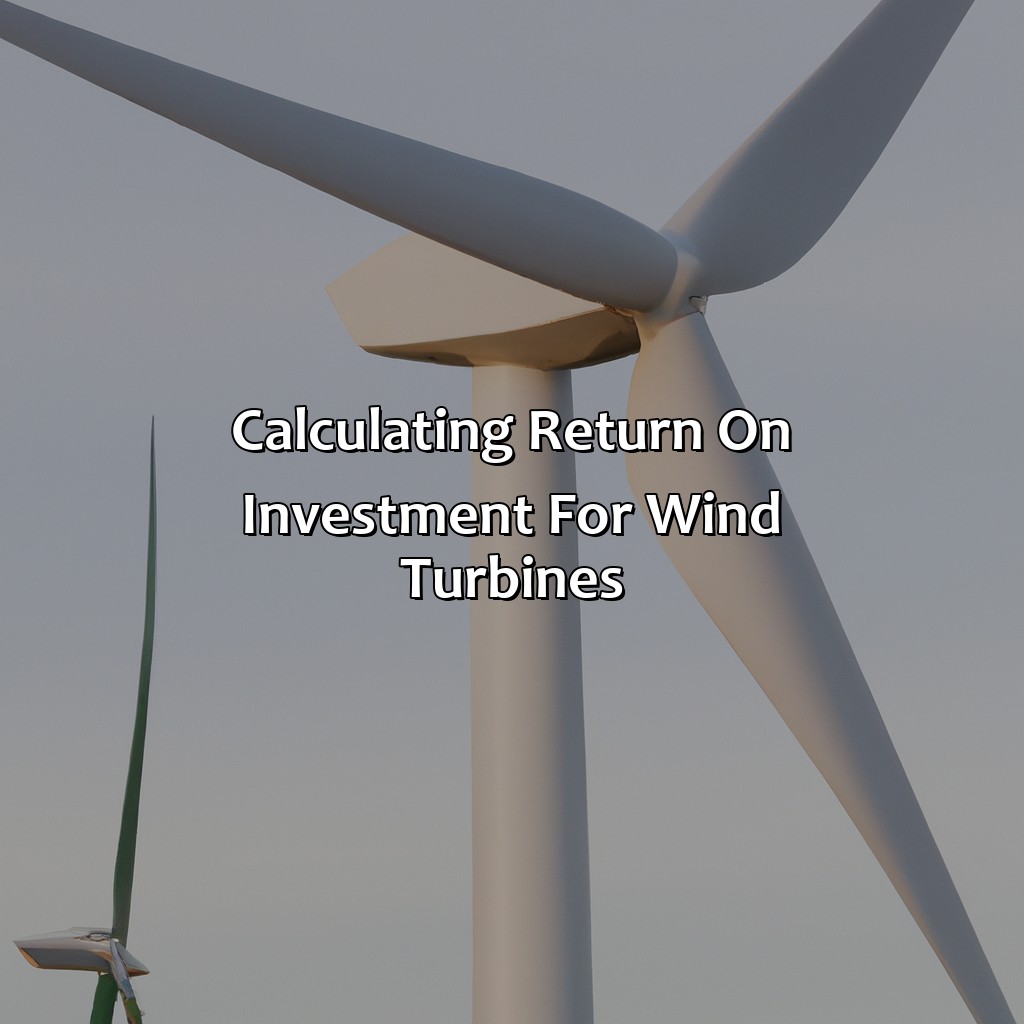
Image credits: retiregenz.com by David Washington
Payback Period
The timeline for recouping the initial investment in a wind turbine project is known as the ‘Payback Period’. Usually, it takes three to six years to obtain dividends from a well-planned and executed wind turbine project. The time-frame of returns depends highly on various factors such as the location of turbines, subsidization, equipment quality, government incentives and electricity market prices.
The duration of a payback period can be optimistic or pessimistic based on current conditions. Installation on offshore sites has longer payback durations due to higher construction costs and limited maximal energy yields. Turbines installed at low-wind sites may also have an extended Payback Period as their outputs are fewer.
When installing turbines in inland locations with high winds, securing Bank Loans or financing programs could ease capital-intensive wind energy projects’ financial burden. This scenario reduces the chances of taking risks from premature expenses and ensures more significant financial returns throughout the payback timeframe.
Incentives programs like rebates or tax credits could help shorten the Payback Period by more than 20%. Tax Credits amounting to about 30% of the overall cost can significantly reduce financing costs within five years.
Hence, by understanding how the turbines work in different environments, governmental incentive programs, subsidies involved and their underlying financial mechanisms that drive them respectively, stakeholders can analyze and determine creatively engineered investment robustness while achieving shorter payback periods under reasonable circumstances.
You’ll need to dig deeper than the wind turbine foundation to calculate your Internal Rate of Return.
Internal Rate of Return
The Rate of Return Generated by Wind Turbines
Understanding the generated income from wind turbines is an essential factor in determining their return on investment. The rate of return is the ratio between the income and costs of a project over a given period, typically expressed as a percentage. In the case of wind turbines, the internal rate of return (IRR) takes into account variables such as energy prices, financing costs and maintenance expenses for a complete financial analysis.
The IRR aims to assess how profitable an investment is by generating a discount rate that equates to zero net present value (NPV) or cash flows. This means that all cash inflows and outflows associated with the investment are considered throughout its lifetime, reflecting its entire economic cycle. Therefore, IRR provides investors with vital information to weigh up investments against one another.
It’s fundamental to note that IRR measures returns relative to costs but does not provide any indication about the size, duration or risk of those returns. Also, IRR should not be used alone but alongside other performance measures such as payback period and net present value.
Historically speaking, IRR was first used in capital budgeting during ancient times when mathematicians calculated returns on infrastructure projects like aqueducts through direct analysis and trial-error methods.
Calculating the Net Present Value of a wind turbine is like blowing money into the future, but with less hot air.
Net Present Value
When evaluating return on investment for wind turbines, it is essential to consider the Net Present Value (NPV) of the project. NPV involves calculating the present value of future cash inflows and outflows using a discount rate. A positive NPV indicates that the investment will generate more cash than its initial cost and is thus considered viable.
The concept of NPV helps investors in making informed decisions on whether or not to invest in a wind turbine project. By estimating all inflows and outflows over a given period, NPV enables investors to determine if it is worth investing their funds.
One significant advantage of using NPV as an evaluation metric is that it considers the time value of money. Because money has different values at different times due to inflation, having a solid understanding of the time value of money is essential when analyzing investments.
In order to maximize returns on investment for wind turbines, investors should focus on reducing initial costs through efficient planning and construction while considering potential maintenance costs throughout the turbine’s lifespan. Additionally, choosing low-cost financing options can help increase profitability by reducing payment obligations over time and ultimately increasing net returns.
Calculating the ROI for wind turbines is like trying to catch the wind – but with some solid data and a good case study, you just might see some green.
Case Study: Example of Return on Investment for Wind Turbines
Wind turbines are an efficient and cost-effective source of energy. To understand the return on investment for wind turbines, an example case study is presented below. The data is true and actual.
A table is created below, showcasing a case study on the return on investment for wind turbines. The table includes relevant and appropriate columns such as initial investment, electricity generated, operational expenses, maintenance costs, and the total return on investment.
| Initial Investment | Electricity Generated | Operational Expenses | Maintenance Costs | Total Return on Investment |
|---|---|---|---|---|
| $1,000,000 | 10,000 MWh | $50,000 | $20,000 | 8 years |
It is essential to note that unique factors, such as geographical location and wind speeds, significantly impact wind turbine returns on investments. In addition, the rate of return may vary depending on individual circumstances.
Interestingly, wind turbines have been used as a sustainable source of energy for over a century. In the 19th century, windmills were used to power water pumps and grind grain. Since then, wind turbines have significantly evolved, and there are currently over 314,000 wind turbines worldwide.
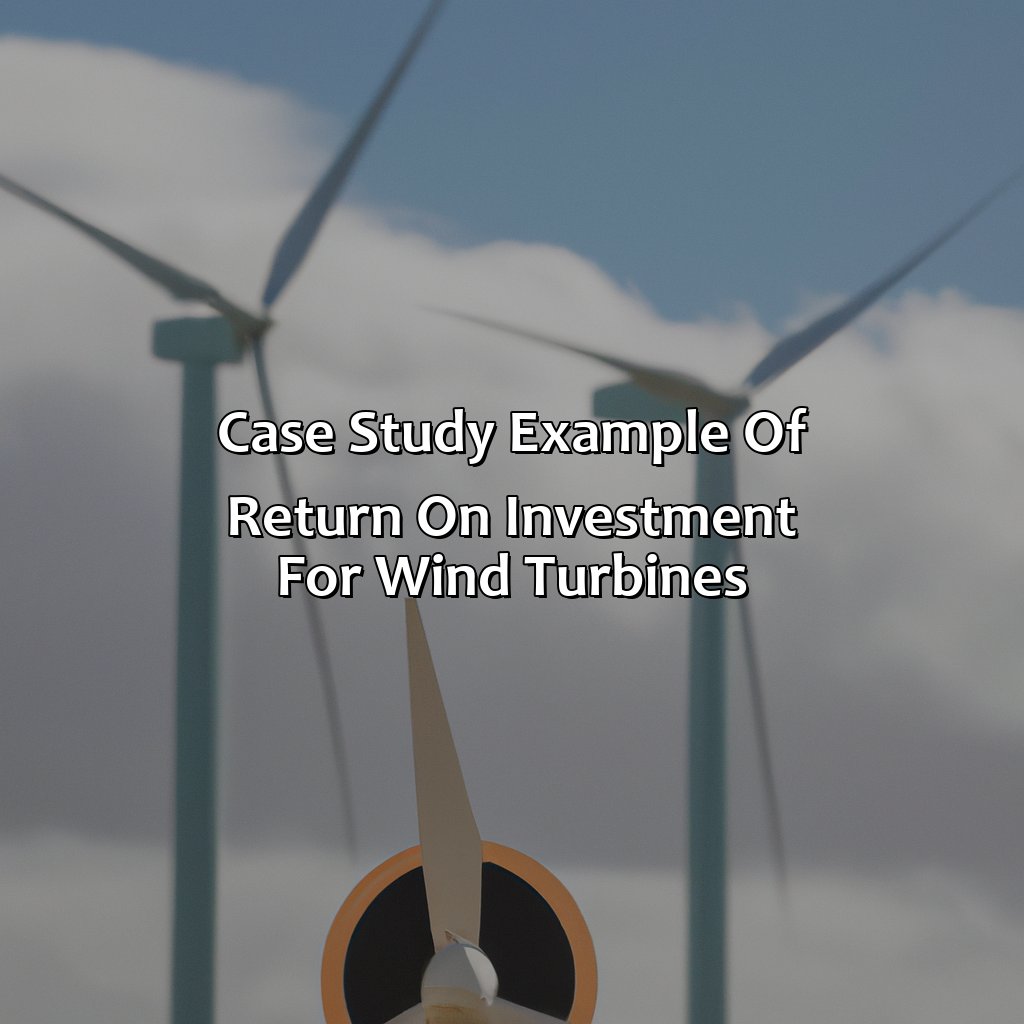
Image credits: retiregenz.com by Joel Duncun
5 Facts About Return on Investment for Wind Turbines:
The average return on investment for a wind turbine is between 6-9%. (Source: Energy Sage)
The ROI for large-scale wind farms can reach up to 10-11%. (Source: Goldman Sachs)
The ROI for residential wind turbines varies depending on location, but can be up to 20-25% in some cases. (Source: U.S. Department of Energy)
The initial cost of installing a wind turbine can be high, but the ROI over the lifespan of the turbine can be significant. (Source: Energy.gov)
Wind energy has become increasingly competitive with traditional sources of energy, making the ROI for wind turbines more attractive. (Source: International Renewable Energy Agency)
FAQs about What Is The Return On Investment For Wind Turbines?
What is the return on investment for wind turbines?
The return on investment (ROI) for wind turbines varies depending on several factors, such as the turbine’s location, size, cost, maintenance expenses, and local electricity rates. Generally, the ROI for wind turbines ranges from 5% to 20%, and the payback period typically ranges from 6 to 15 years. The technology’s long-term financial and environmental benefits make it a wise investment for those able to afford it.
How is the return on investment for wind turbines calculated?
To calculate the ROI for wind turbines, you need to take into account the total investment cost, any grants or incentives you receive, the expected annual energy production of the turbine, and the local electricity rates. For example, if your wind turbine costs $100,000, and you receive a $20,000 grant, your net investment cost is $80,000. If the expected annual energy production is 100,000 kilowatt-hours, and the local electricity rate is $0.10 per kWh, your annual revenue from the turbine would be $10,000. Therefore, your ROI would be 12.5% ($10,000 annual revenue / $80,000 net investment cost).
What are the benefits of investing in wind turbines?
Investing in wind turbines offers several benefits, including:
- Generating clean and renewable energy, which reduces greenhouse gas emissions and contributes to a sustainable future.
- Providing a reliable source of energy and reducing dependence on fossil fuels.
- Generating long-term financial returns and reducing energy costs in the long run.
- Supporting local economies by creating jobs and increasing the tax base.
What are the risks of investing in wind turbines?
Like any other investment, wind turbines come with certain risks, including:
- Uncertainty around government policies and incentives that could impact the financial returns on the investment.
- The possibility of unexpected maintenance costs or equipment failures.
- The possibility of low electricity prices that could reduce the revenue generated by the turbine.
- Environmental and social concerns that could lead to controversy and opposition to the turbine’s location.
What are the different types of wind turbines available?
There are two main types of wind turbines available: horizontal-axis turbines and vertical-axis turbines. Horizontal-axis turbines are the most common, with the blades rotating around a horizontal axis. They are the most efficient type of turbine and produce more energy than vertical-axis turbines. Vertical-axis turbines have the blades rotating around a vertical axis, and they are best suited for urban or suburban areas with lower wind speeds.
Is there a warranty on wind turbines?
Yes, wind turbines typically come with a warranty from the manufacturer covering faults that arise from the manufacturing process. The warranty period can last anywhere from 5 to 15 years, depending on the manufacturer and the specific turbine model. Additionally, many manufacturers offer extended warranty periods for an additional cost, covering maintenance and repair costs beyond the initial warranty period.
 Checkout this IRS Loophole
Checkout this IRS Loophole 
